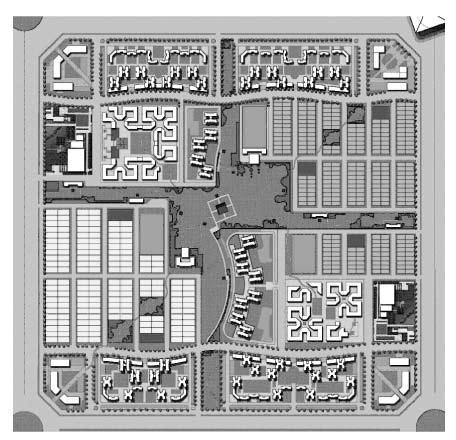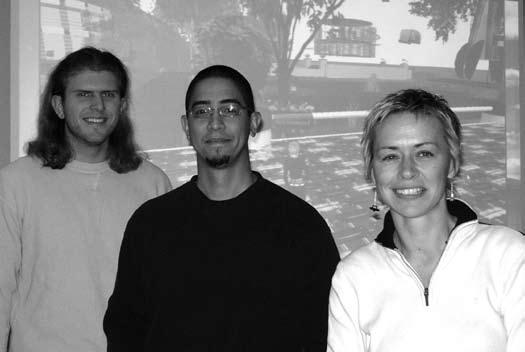
5 minute read
Chatterjee Designs New Capital City
Not many designers have an opportunity to have an impact in designing a brand new capital city, but that is exactly what Dr. Sudeshna Chatterjee (Ph.D. 2006) is doing in the new Indian state ofChhattisgarh. Chatterjee is working on the conceptual visualization ofthe whole city based on a land use plan and transportation grid worked out by the planners. As the urban designer, Chatterjee contributed to the development ofthe masterplan by introducing human scale and appropriate grains to the development zones with due consideration for good urban form, symbolism, imagery and aesthetics. She brought in latest research understanding to setting development goals and creating urban design standards and guidelines for this 21st century capital city. Chatterjee is the first woman urban designer to lead the creation ofa design-led vision for a capital city anywhere in the world. “I never thought I would design a capital city, simply because there are so few ofthem designed from scratch,” Chatterjee says, “I was very careful to understand what has historically made capital cities special. I tried to adapt some ofthe time-tested urban design ideas that had allowed capital cities to express power and solidify their identities and married them to present discourses on sustainable design, green urbanism and human cities with a special focus on pedestrians, women, children and people with different abilities to create a capital city that is green, equitable and responsive to the everyday needs ofall citizens.” A partner in Kaimal Chatterjee and Associates, an architecture, urban design and research practice, Chatterjee nowlives in NewDelhi. Herproject in Chhattisgarh is designing the most important areas ofthe capital city ofNaya Raipur including the Central Business District, transportation hubs, the area around the capitol complex as well as typical residential neighborhoods. Chatterjee says, “a cityplan does not create a citybyitself. A car-free central plaza with multiple activity settings and spaces for display of local art in the heart of the Central Business District.

Advertisement
Historically this is a complex process ofnegotiations and collaborations. In this case, public-private partnerships will give physical shape to the city plan with the state playing a more regulatory role. That is why it was important to create a verydetailed design code for the citywhich laid out for its builders the intention for future developments as well as ways to attain them in an equitable, sustainable and successful manner.” Chatterjee’s award-winning background in urban design and children’s environments began in her native Calcutta, India, where she went to architecture school at Jadavpur University Calcutta. She received first class honors for her B.Arch degree and the best final year architectural thesis award. Fascinated by large urban-scale projects and the complexities of cities, Chatterjee continued her studies in the master ofurban design program in the School ofPlanning and Architecture in New Delhi. There, she received the departmental gold medal for best urban design student and the T.J. Manickam gold medal for best graduate thesis among all departments in 1997-98.
She worked as an urban designer and architect in the practice ofJoseph Allen Stein (Stein Mani Chowfla Architects) until 2002. During her spare time, she actively devoted time to non-governmental organizations (NGOs) that design and enhance children’s environments such as parks, play schools and school for special needs children. With a goal to become an expert on research and design ofchildren’s environments, especially in developing cities, Chatterjee began working as a research associate with the Habitat International Coalition’s Housing and Land Rights Network in Delhi. She developed work on children’s housing rights in South Asia, resulting in two international publications and gained first-hand networking with officials from the United Nations Child-Friendly Cities Secretariat in international conferences. This experience and networking greatly benefited her in designing her Ph.D. dissertation on child-friendly cities. In 2001 she won a Mellon short-term fellowship to attend an interna tional seminar series titled “Contested Childhood in a Changing Global Order” held at the UniversityofMichigan in Ann Arbor. Chatterjee made the decision prior to the seminar that she wanted to pursue a Ph.D. She chose to studyat NC State so she could work with Robin Moore, director ofthe Natural Learning Initiative and professor in landscape architecture. Continuing to win awards for her research, Chatterjee’s dissertation was selected as the onlyNC State nominee to the national CGS/microfilms International Distinguished Dissertation awards in the field ofFine Arts/Humanities. Her dissertation is titled “Children’s Friendship with Place: An Exploration ofEnvironmental Child Friendliness of Children’s Environments in Cities.” In April 2006, while Chatterjee was preparing for her dissertation defense in Raleigh, she was invited to serve as the News Archive Editor for the international peer-reviewed journal, “Children, Youth and Environments (CYE).” She has since contributed over 50 news stories on the subject to CYE and has been made a research affiliate ofthe Children, Youth and Environments Center for Research and Design at the University ofColorado, Boulder. Chatterjee also has a hand in designing several schools as developmentally adequate and child-friendly environments, including the first environmental school in the central Himalayas through community participation. She is also an integral part ofa new initiative to provide sustainable community owned rural education in villages across India.

Her firm was selected to redesign the public spaces ofApollo Hospital, the largest, private hospital in New Delhi. Recently, Chatterjee was invited to Phnom Penh, Cambodia, by the World Education and Cambodia Living Arts (CLA) to understand how performing arts have been revived in that country through the intervention oforganizations such as CLA. This preliminary research is exploring the possibility ofa new arts-led planning vision ofthe cityincluding creation ofan arts district in Phnom Penh to promote the cityas a venue for big international arts events. “I feel really happy that I had been given the opportunities to use my training in communityand environmental design research to understand the needs ofa communitybefore developingpolicies or designs to bringin preferred change through physical interventions,” she says. Chatterjee continues to teach graduate courses in the School of Planningand Architecture in NewDelhi, and workas an editor, writerand reviewer for CYE and EDRA. As for the future, she hopes to publish her dissertation into amonograph. She also wants to write achildren’s bookon some ofthe findings she feels have greatvalue forenvironmental education. The Arab Urban Development Institute is spearheading an international initiative to create child-friendlycities across the Middle East by creating the right regional, national and local policies. Chatterjee has been engaged by AUDI as a resource person with international expertise on child-friendly cities to provide content and peer review regarding the new policies and guidelines emerging out ofthis initiative. However, her goal of making cities childfriendly through design is coming true by being an integral part ofdesigning this new capital city—a once in a lifetime opportunity. Typical Residential Sector Layout – A multi-nodal open space system with pedestrian and cycle routes that connects the neighborhood end to end and centers the diverse mix of housing types around a shared community space.











